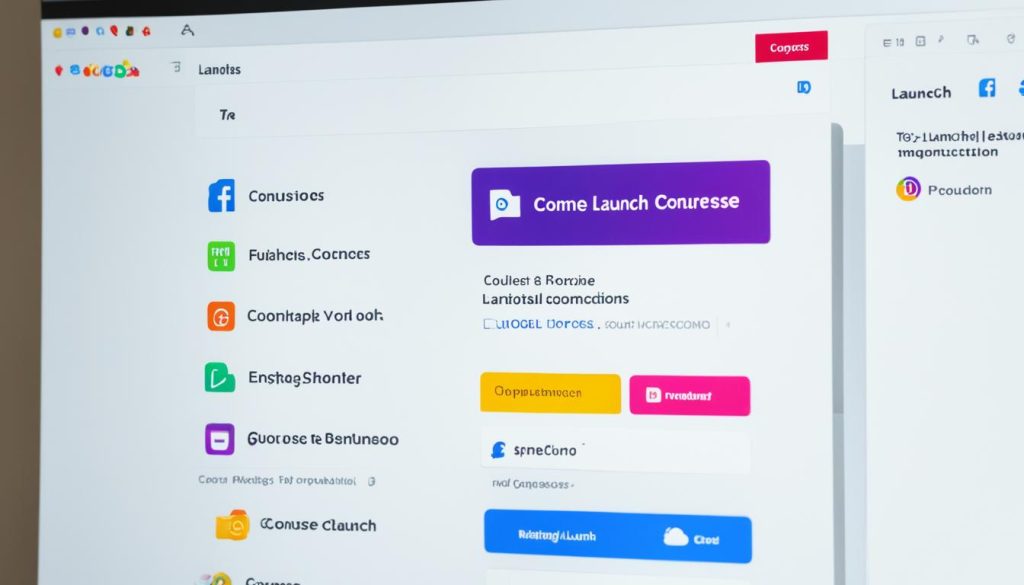Did you know the global e-learning market will hit $374 billion by 2026? This shows the huge chance for creators like you to make online courses. You can use your blog to become a top expert in your area. You can also build a community and reach more people from home.
This guide will show you how to make and sell online courses. It covers picking the right topic to setting up a website for your course. It’s for both experienced content creators and beginners. You’ll learn the tools, strategies, and best practices for online education success.
Choosing the Right Topic for Your Online Course
Starting a successful online course means picking the perfect topic. With so many choices, it’s key to find a subject that could really take off. Think about your target audience, your subject matter expertise, and the market demand for your topic.
Define Your Target Audience
First, figure out who you want to teach. Who do you want to help with your course? Do some audience research to learn what they need and what they’re looking for. This way, you can make sure your course hits the mark.
Pick a Subject You’re Passionate About
Then, pick a topic you really care about. Your subject matter expertise and excitement will show in your course. This makes your course more engaging for your students. Teaching something you love makes the learning experience better for everyone.
Validate the Demand
It’s also important to check if people want your course. Do some course topic research to see if there’s interest and competition. Look at online searches, social media, and other courses to understand what people like and what you can offer.
By thinking about your audience, your expertise, and what people want, you can pick the best topic for your course. This sets you up for a successful and engaging course.
Validating Your Online Course Idea
Before you start working on your online course, it’s key to check if people want it. This step makes sure there’s a market for your course, reducing the risk of making something that won’t sell. You can validate your idea by testing it with a landing page and setting clear goals and KPIs.
Test Your Idea with a Landing Page
Create a simple landing page using a landing page builder to introduce your course. Share this page and see how people react. Look at page views, email signups, and any feedback you get. This will show if your target audience is really interested in your online course idea.
Set Goals and KPIs
Before you begin, set clear goals and key performance indicators for your online course. This way, you can see how successful your landing page testing is and if your idea works. Important KPIs to watch include:
- Number of visitors to your landing page
- Percentage of visitors who sign up for your email list
- Conversion rate of email subscribers to course sales
- Revenue generated from pre-sales or early bird offers
With clear goals and KPIs, you can check if there’s demand for your course. This helps you decide if it’s worth developing further.
Researching and Outlining Your Course Content
Creating a detailed course means really getting to know your topic. If you’re already an expert or want to learn more, now’s the perfect time to dig deep. Look beyond basic info online and find credible sources to broaden your knowledge.
Conduct In-Depth Research
Begin by doing keyword research to see what your audience is searching for. This shows you the topics and issues you should cover in your course. Look at various sources like industry magazines, expert blogs, online forums, and educational materials. Make sure you fully grasp the details and complexities of your course research.
Create a Structured Course Outline
- Make a clear course outline that shows the structure and order of your lessons.
- Set clear learning goals for each module to help with lesson planning and make sure your content meets your students’ needs.
- Arrange your material in a logical, step-by-step way, so your audience can easily follow along with the curriculum development.
- Find any missing areas or topics that need more topic deep dive to make your course complete and valuable.
By doing thorough research and making a detailed course outline, you’re on your way to creating a course that really speaks to your audience. It will also show you as an expert in your field.
Selecting an Online Course Platform
Choosing the right platform to sell your online course is key. There are many options like online course hosting platforms, website builders, learning management systems, and course creation tools. Each has different features to help your course business. You need to pick one that matches your goals and needs.
When looking at online course platforms, think about these things:
- Customization options – Find platforms that let you design your course with many templates and tools.
- Content management – Make sure the platform has great features for uploading, organizing, and delivering your course. This includes video hosting, quizzes, and interactive parts.
- Marketing and sales tools – Choose a platform that works well with email marketing, affiliate programs, and other ways to promote your courses.
- Pricing and monetization – Know how the platform charges and any fees to make sure it fits your business and earnings goals.
- Ease of use – Pick a platform that’s easy for you and your students to use, so there’s not too much to learn.
By picking the right online course platform, you’ll be ready to create and sell your courses with confidence and success.
| Platform | Key Features | Pricing |
|---|---|---|
| Teachable |
|
|
| Kajabi |
|
|
| Thinkific |
|
|

Create online courses blog
Starting to build an online course website means adding a blog. A blog is great for blog integration and course sales funnel growth. It lets you share useful content, connect with your audience, and grow a community around your course.
When setting up your online courses blog, think about these key points:
- Consistent Posting Schedule: Stick to a regular posting schedule, like weekly or bi-weekly. This keeps your audience interested and engaged with your content.
- Diverse Content Topics: Share a mix of course-related and other topics your audience will find helpful. This draws in new readers and shows off your knowledge.
- Interactive Elements: Add things like comments, polls, or quizzes to make your blog more engaging. This encourages your readers to get involved.
- Promotion and Cross-Promotion: Use your blog to promote your course, and your course to promote your blog. This creates a smooth course sales funnel by linking relevant blog posts to your courses.
Adding a well-thought-out blog to your online course site improves the user experience, builds brand loyalty, and boosts course sales. Spend time on a strong blog integration plan to help your online course business grow and succeed.
Creating Engaging Course Content
Creating an online course is more than just recording lectures. You need to use different multimedia formats and design tips to make it engaging. By using what you already have and following tested methods, you can make a course that grabs your learners’ attention and helps them remember more.
Repurpose Existing Materials
If you’re already an expert in your course topic, look at what you’ve made before. This could be blog posts, webinars, podcasts, or videos. Think about how you can use this stuff to make your course better. For instance, turn a hit blog post into a PDF guide or a podcast into an extra audio lecture.
Follow Best Practices for Content Creation
- Break content into easy-to-follow lessons or modules to keep learners interested.
- Use a mix of multimedia like videos, quizzes, forums, and interactive activities.
- Keep in mind the best ways to make course content development, instructional design, and learner engagement techniques work together.
- Make sure there are chances for practice, feedback, and applying what they’ve learned throughout the course.
| Multimedia Format | Benefit |
|---|---|
| Videos | They make course topics come alive with visuals and sounds. |
| Quizzes | They’re fun ways to check understanding and give feedback. |
| Discussion Forums | They help students learn from each other and build a community. |
| Downloadable Resources | Students can use these extra materials even after the course ends. |

By using what you already have and following the best ways to use multimedia formats and instructional design, you can make an online course that really speaks to your students. It will help them learn in a meaningful way.
Pricing and Income Goals for Your Online Course
Pricing your online course is key to reaching your revenue goals. Whether you want to earn $1,000 or $10,000, setting clear targets helps you find the best price. Using premium pricing has many benefits:
- Fewer Students, Greater Returns: Charging more means you can earn your income with fewer students. This lets you give more personal attention and better results.
- Attract a More Engaged Audience: Premium prices draw in students who are more committed. This leads to higher engagement and better outcomes.
- Boost Overall Revenue: Besides premium pricing, try course bundles, upsells, and cross-sells. These strategies can increase your course’s earnings.
Don’t think pricing your course is the same for everyone. Research your market, think about the value you offer, and try different prices. This way, you’ll find a price that matches your goals and strategy.
Launching and Marketing Your Online Course
Congratulations! You’ve finished making your online course content. Now, it’s time to get it out there and reach your audience. Good launch and marketing plans are key to getting your course off the ground and growing your business.
Build a Compelling Sales Page
Your sales page is crucial for launching your course. Make it look good and convince people why they should join. Show off what your course offers and how it can change their lives. Use clear language and eye-catching visuals to get more people to sign up.
Leverage Your Existing Audience
Using your current followers is a strong way to market your course. Your blog readers, social media fans, and email subscribers already trust you. Share interesting content that gets them excited for your course. Offer special deals or bonuses to get them to sign up early.
Don’t just stick to your own channels. Try out marketing strategies like content marketing, paid ads, and working with affiliates to reach more people. A mix of ways to promote your online course launch and connect with your audience will help your course stand out and sell better.

Building an Online Course Community
Creating a strong community of students is key for better learning, staying on track, and loyalty in your online course. By letting learners connect with each other, you make a place that’s lively and supportive. This makes learning more fun and effective.
Discussion forums are a great way to build community. They let students share thoughts, ask questions, and learn from each other. Encourage your students to join in these forums. This sharing of ideas and experiences can make them understand the course better.
Social media groups can also help build community. These online spaces let students connect on a personal level. They can share their progress and work together on projects. This helps your students feel like they belong to a caring and active community.
Think about hosting live events like webinars or virtual meetups too. These events let students talk to you and each other in real-time. They can ask questions, discuss topics, and even mentor each other. This can make your community feel closer and more engaged.
To build a great online course community, focus on keeping students engaged. Offer many ways for peer-to-peer learning and collaboration. This approach creates a supportive and lively place. It keeps students motivated, connected, and committed to your course.
Gathering Feedback and Improving Your Course
Getting course feedback from students is key for making your course better and keeping students happy. Use surveys, one-on-one talks, and other ways to get feedback. This helps you spot areas to improve. Then, you can make changes that meet your students’ needs, making the course more engaging and effective.
Create a feedback loop with your students. Ask for their thoughts and experiences all through the course, not just at the end. Use feedback forms in the course, send out surveys after modules, and get feedback on social media. Answer reviews and testimonials quickly to show you care about making the course better.
Look at the feedback you get to see what’s working and what’s not. Use this info to update your course content, make the course better, and improve the learning experience. Remember, your students know what they need, so listen to them and use their feedback to improve your course.
| Feedback Collection Methods | Benefits |
|---|---|
|
|

By asking for and listening to course feedback, you show you care about your students’ success. You’re open to making changes and improving your course. This makes the learning experience better and builds trust with your students, making your course a valuable resource that keeps getting better.
Exploring Additional Revenue Streams
As an online course creator, your main goal might be to sell your core courses. But to really boost your earnings and spread out your income, look into more ways to make money. Using course bundling, upsells, and cross-sells can help you make more money and keep your business growing.
Offer Course Bundles
Think about putting your online courses together into bundles. Bundling courses gives your students more value and lets you charge more for it. This can really help you make more money.
Implement Upsells and Cross-Sells
Upselling and cross-selling can increase how much money you make from each customer. An upsell could be a special version of your main course with extra features or personal coaching. A cross-sell might be another course or product that makes the first one even better.
- Upsell premium course add-ons or coaching services
- Cross-sell related courses or complementary products
- Always look for new course bundling, upsell, and cross-sell chances
By using these methods to diversify your income, you can build a strong and growing online course business. This way, you can meet the changing needs of your students.
Leveraging Your Blog for Course Sales
If you have a blog, use it to boost traffic and sales for your online course. By adding your course to your blog, you make a strong team. This team helps your content marketing and brings in more leads.
Integrate Your Course with Your Blog
Begin by setting aside pages or sections for your online course on your blog. You could have a course landing page, details on the course, and content upgrades related to the course. Make sure these parts look and feel like they belong with your blog’s design and brand.
Use Your Blog to Promote Your Course
- Educate your audience: Use your blog to share valuable content related to your course. This can be tutorials, industry insights, and thought-leadership pieces.
- Build authority: Regularly posting high-quality content makes you a trusted expert in your field. This makes your course more attractive to potential students.
- Promote your course: Show off your course’s benefits on your blog. Share testimonials from past students and any special offers or discounts you have.
By linking your online course with your blog and promoting it there, you create a strong blog-course integration. This approach boosts content marketing, lead generation, and promotional strategies for your online course business.

Staying Up-to-Date with Online Education Trends
In the fast-changing world of online education, it’s key to keep up with the latest trends, instructional technology, learner preferences, and course monetization strategies. By staying informed, you can make sure your courses stay interesting, relevant, and flexible for your students.
One big trend is mobile learning, which lets students learn anytime, anywhere. Making your materials work well on mobile and using microlearning can make learning on mobile better. Also, personalized learning paths and social learning can help students stay engaged and remember more.
Looking into gamification, virtual reality, and artificial intelligence can make your online courses more exciting. These new technologies can make learning more fun, help students remember more, and open up new ways to make money.
| Trend | Description | Impact on Online Education |
|---|---|---|
| Mobile Learning | Accessing course content anytime, anywhere on mobile devices | Improved accessibility, personalized learning, and flexible engagement |
| Microlearning | Bite-sized, focused learning modules | Enhanced knowledge retention, better fit for modern learners’ attention spans |
| Gamification | Incorporating game-like elements into the learning experience | Increased motivation, engagement, and course completion rates |
| Virtual Reality (VR) and Augmented Reality (AR) | Immersive, interactive learning environments | Elevated learning experiences, improved skill development, and new monetization opportunities |
| Artificial Intelligence (AI) | Personalized learning recommendations, automated assessments, and chatbot-powered support | Customized learning paths, enhanced learning analytics, and improved learner experiences |
By keeping up with these trends and adapting your courses, you can offer more engaging, effective, and profitable learning experiences for your students.
Scaling Your Online Course Business
As your online course grows, it’s time to think about making it bigger for long-term success. You might add more courses, automate some tasks, work with partners, or put profits back into growing your business. By always making your course better and finding new ways to make money, you can make your online course a lasting and growing business.
To make your course business scalability better, think about making more courses or adding new parts to your current one. This can help you reach more people and make more passive income. Also, making your business run smoother by automating tasks and hiring others can help you focus on making new content and marketing.
Working with influencers, experts, or other businesses can help your audience growth. These partnerships can bring your course to new people, make your marketing stronger, and give you new ideas to improve your courses. Putting your profits back into making more courses, marketing, or growing your business can keep your growth going strong.

